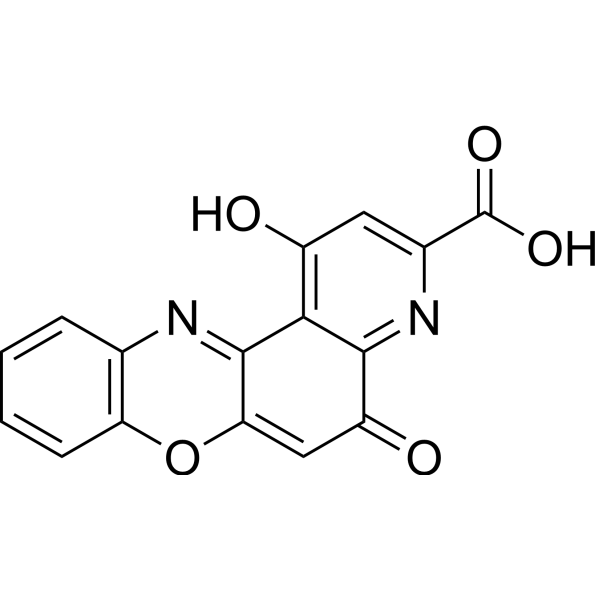Pirenoxine
Modify Date: 2025-08-23 15:34:48

Pirenoxine structure
|
Common Name | Pirenoxine | ||
|---|---|---|---|---|
| CAS Number | 1043-21-6 | Molecular Weight | 308.25 | |
| Density | 1.7g/cm3 | Boiling Point | 515.8ºC at 760mmHg | |
| Molecular Formula | C16H8N2O5 | Melting Point | 247-248ºC | |
| MSDS | N/A | Flash Point | 265.7ºC | |
Use of PirenoxinePirenoxine (Catalin K) is a potent antioxidant. Pirenoxine shows anti-presbyopic activity. Pirenoxine has the potential for the research of cataracts[1][2]. |
| Name | 1,5-dioxo-4H-pyrido[3,2-a]phenoxazine-3-carboxylic acid |
|---|---|
| Synonym | More Synonyms |
| Description | Pirenoxine (Catalin K) is a potent antioxidant. Pirenoxine shows anti-presbyopic activity. Pirenoxine has the potential for the research of cataracts[1][2]. |
|---|---|
| Related Catalog | |
| In Vivo | Pirenoxine (0.005% pirenoxine;滴眼液) 抑制晶状体硬化并防止老花眼的发展[2]。 Animal Model: Six-week-old male Sprague-Dawley rats[2] Dosage: 0.005% pirenoxine Administration: Eye drop Result: Significantly suppressed lens hardening. |
| References |
| Density | 1.7g/cm3 |
|---|---|
| Boiling Point | 515.8ºC at 760mmHg |
| Melting Point | 247-248ºC |
| Molecular Formula | C16H8N2O5 |
| Molecular Weight | 308.25 |
| Flash Point | 265.7ºC |
| Exact Mass | 308.04300 |
| PSA | 113.52000 |
| LogP | 2.24480 |
| Vapour Pressure | 1.83E-11mmHg at 25°C |
| Index of Refraction | 1.793 |
| 1-hydroxy-5-oxo-5H-pyrido[3,2-a]-phenoxazine-3-carboxylic acid |
| Pirenoxina [Spanish] |
| 1,5-dioxo-1,5-dihydro-4H-pyrido[3,2-a]phenoxazine-3-carboxylic acid |
| pirenoxine |
| Pirenoxinum |
| EINECS 213-872-4 |
| 1-Hydroxy-pyrido-5-phenoxazon-3-carbonsaeure |
| Pirenoxinum [Latin] |
| Catalin |
| Catalin-K (TN) |
| MFCD00867148 |
| Pirenoxina |
| pirfenoxone |